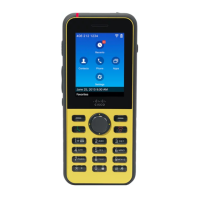•
Best Effort (BE) - 0, 3
•
Background (BK) - 1, 2
•
Video (VI) - 4, 5
•
Voice (VO) - 6, 7
The device marks the SIP signaling packets with a DSCP value of 24 (CS3) and RTP packets with DSCP
value of 46 (EF).
Note
Call Control (SIP) is sent as UP4 (VI). Video is sent as UP5 (VI) when Admission Control Mandatory
(ACM) is disabled for video (Traffic Specification [TSpec] disabled). Voice is sent as UP6 (VO) when
ACM is disabled for voice (TSpec disabled).
Note
The following table provides a QoS profile on the AP that gives priority to voice, video, and call control (SIP)
traffic.
Table 3: QoS Profile and Interface Settings
Port RangeWMM UP802.1pDSCPTraffic Type
UDP 16384-3276765EF (46)Voice
UDP 16384-3276754AF41 (34)Interactive Video
TCP 5060-506143CS3 (24)Call Control
To improve reliability of voice transmissions in a nondeterministic environment, the device supports the IEEE
802.11e industry standard and is Wi-Fi Multimedia (WMM) capable. WMM enables differentiated services
for voice, video, best effort data and other traffic. For these differentiated services to provide sufficient QoS
for voice packets, only a certain amount of voice bandwidth can be serviced or admitted on a channel at one
time. If the network can handle “N” voice calls with reserved bandwidth, when the amount of voice traffic is
increased beyond this limit (to N+1 calls), the quality of all calls suffers.
To help address issues with call quality, an initial Call Admission Control (CAC) scheme is required. With
SIP CAC enabled on the WLAN, QoS is maintained in a network overload scenario by limiting the number
of active voice calls so as not to exceed the configured limits on the AP. During times of network congestion,
the system maintains a small bandwidth reserve so wireless device clients can roam into a neighboring AP,
even when the AP is at “full capacity.” After the voice bandwidth limit is reached, the next call is load-balanced
to a neighboring AP so as not to affect the quality of the existing calls on the channel.
The phones use TCP for SIP communications, and call control system registrations can potentially be lost if
an AP is at full capacity. Frames to or from a client that has not been "authorized" through the CAC can be
dropped, leading to call control system deregistration. Therefore, we recommend that you disable SIP CAC.
Cisco Wireless IP Phone 8821 and 8821-EX Administration Guide for Cisco Unified Communications Manager
22
VoIP Networks
QoS in a Wireless Network

